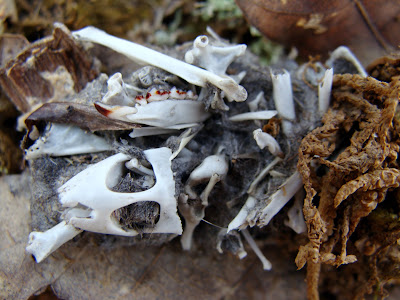 |
| Owl pellet w/ frog skull and shrew's jaw |
I can't believe I didn't post this before. How did I skip this?!? We found this in early spring (while looking for mushrooms).
Okay. In case you didn't know, owls eat their prey whole (if they can), and then skip the parts they can't digest. They regurgitate it. But, never mind that part, what's cool is that you can tell what they ate, if you learn your bones (or beetles. Sometimes they eat bugs, if there's nothing better around, and you can see the wing cases etc.). Not quite sure why I think that's cool, but I do.
So, the frog skull was pretty easy (for some reason I knew what a frog skull looked like), but my mind kept wandering back to those red teeth. I didn't give it much attention at first--I just thought, "Oh, look, discolored teeth, something maybe old." But that was no rodent, so what the heck was it? Based on the size, there weren't many options (shrews,
*(Oops--voles ARE rodents)
I started to poke around, looking up God-knows-what on the Interwebs, until I finally started typing in things like "red teeth" and "skull ID" and found that there's a whole family of shrews called "Red-toothed shrews"! And their teeth are red because of iron deposits in the enamel! And the iron makes their teeth harder! Which they need because they eat so much to keep going! And they have to eat so much (their body weight every day, or up to triple that in some species) because their metabolism is insanely high! Heart rates measured at 800 beats per minute (a resting hummingbird's is 250)! And they can die from fright (being so high-strung), and they are quite stinky from some kinda scent glands they have (so, cats will kill them but rarely eat them, because they stink, but birds in general have a poor sense of smell so they don't care and will eat them), and they only live about 15 months, can have 2 to 4 litters in that time, hate all other creatures including other shrews, and are great to have around your property to keep the bug population down. All they do is eat, breed, and get mad at other shrews. And stink, I guess. Could be worse.
Oh, wait, there's also toxins in their saliva that paralyze their prey (snails, crickets, etc.) and can really swell and hurt if you get bit.
But really, other than those things, that's all.
I was just curious about the red teeth!


